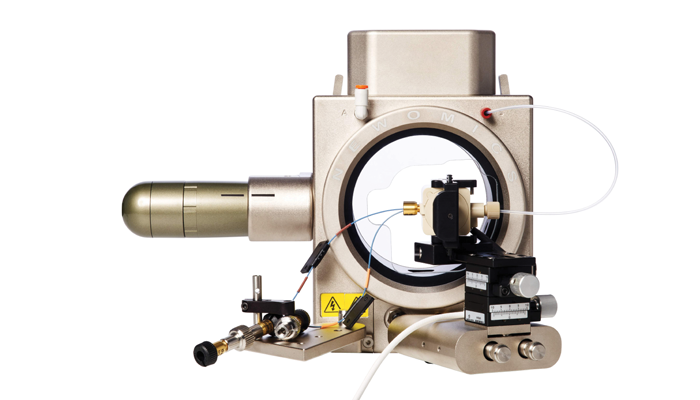
The term “native MS” was coined in 2004, but the practice of native MS began in the labs of Brain T. Chait, Jack Henion, Joseph A. Loo, and others independently in the 1990s – not long after the invention of ESI by John Fenn and his colleagues in 1989. Native MS strives to study biomolecules and their interactions under native (or non-denaturing) conditions by mass spectrometry. Typically, analytes are sprayed from aqueous solutions with pH and ionic strength akin to those under physiological conditions, ionized in the gas phase, and detected in the vacuum by a mass spectrometer.
Over the past five years, native MS has gained significant traction, which is mainly due to two key factors. The first is the dramatic improvement in the performance of mass spectrometers, particularly the high mass resolution, range, and accuracy offered by UHMR Orbitrap and now Astral from Thermo Fisher Scientific, as well as various Q-TOF instruments from Bruker, Agilent, Shimadzu, Waters, and others. The second important driving factor has been the critical needs in: i) structural biology to screen and solve the native structures of protein and other complexes in conjunction with CryoEM; and ii) drug discovery to identify and quantify the binding in the native states.
The main advantage of native MS is that intact biomolecules and their complexes can be sprayed under native conditions in the solution and studied under native-like conformations in the gas phase. This provides the first approximation of the corresponding native conformations under physiological conditions. The other advantage is that the information gained can be directly correlated to those obtained with other structural techniques or binding assays because intact proteins and their complexes are studied directly.
As a result, in recent years many applications have been developed, centered on:
- antibodies
- ADCs
- AAVs
- protein complexes
- protein-drug binding
I believe the fields of structural biology and drug discovery stand to benefit the most – at least, currently. However, despite significant interest from these communities and great progress in recent years, native MS is still considered niche because of the technical challenges in the sample preparation and LC-MS workflow.
For example (setting aside the need for a high-resolution mass spectrometer that can achieve the required high accuracy, resolution, mass range, and sensitivity), high-throughput sample prep and separation – with minimum or no impurity and non-specific binding – can be a challenge. In addition, to achieve efficient spray and ionization under native conditions, low flow, static spray is often performed, which requires laborious sample preparation and does not include chromatographic separation. For high-flow LC-MS, desolvation gas with a high flow rate at a high temperature is required. This may break the weak binding or denature the native biomolecules. Maintaining the native-like interactions and structures after the native spray and during the ion transmission and MS detection is another challenge –as is the robustness and reproducibility of the native MS assay. In my opinion, the most pressing challenge is to achieve efficient native spray of the analytes under high salt conditions, while maintaining the native-like states in the gas phase for sensitive mass spec detection.
Fortunately, advances in the mass spectrometer and bioinformatics solutions for native MS have emerged in recent years. Let me focus on the most pressing challenge mentioned above and point out some recent developments. One is the implementation of Thermo Fisher Scientific’s online desalting column right before the native spray. But the key is to maintain the native state after desalting and before the “native spray.” Another development is implementation of microflow LC-MS using a size-exclusion column (SEC) from PolyLC and coupled directly online with high-resolution mass spectrometry. Here, the challenge is to achieve sufficient chromatographic separation at microflow for big proteins and complexes by SEC. On the native spray front, Newomics has developed the native multispray for native mass spectrometry that achieves the sensitivity, robustness, and throughput required for native MS. Given the growing interest in native MS, I expect a high-throughput front-end solution for integrating sample prep, separation, and native spray is on the horizon.
However, there is a paradox in native MS – one that creates an additional challenge that may be holding the field back. To study analytes in native conditions, they must be sprayed under native-like solvent conditions. On the other hand, organic solvents are more friendly for mass spectrometry. In addition, once the analytes are ionized into the gas phase and enter the vacuum in the mass spectrometer, they are no longer “native” in the traditional sense, even though they may still maintain mostly the folded states and interactions.
In my opinion, a better term for native MS might be “native spray mass spectrometry” (NSMS or NS-MS). This will remove the ambiguity surrounding what “native” means for the technique. Clearly defining which step is native – and decoupling sample preparation, the electrospray process, and mass spectrometry – will promote NSMS technology developments and adoption by a wider group of both MS and non-MS communities.
Native MS has huge potential, but an integrated workflow with high sensitivity, robustness, and throughput is needed if it is to become a mainstream MS application. Adopting the NSMS terminology would, I think, help – alongside further technological developments.





